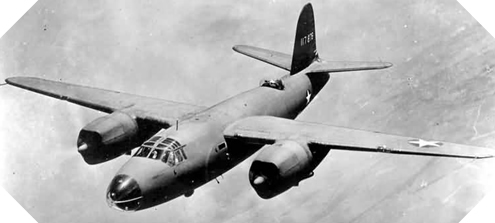Glen Martin B-26 Marauder
History, technical sheet and photo

Glen Martin B-26 Marauder history
A few months before the Second World War, U.S. Air Force wanted to equip its fleet of strategic bombers with a new medium-sized, twin-engine aircraft. The study of such an aircraft began immediately and once the prototype was validated, the bomber named B-26 entered service in 1939.
Deployed on December 8, 1941, the day after the Japanese attack on the American base of Pearl Harbor, the B-26 is engaged on most fronts of the Second World War and mainly in Europe. He is then nicknamed « the Widow Maker », because of its extraordinary efficiency during the bombings.
This fast and handy device strikes quickly and well: very often, during attacks by B-26 Marauder, the anti-aircraft defense batteries do not have time to react. Thus, this bomber is the allied aircraft that is the least killed of all the Second World War.
5,157 copies of B-26 are produced in total. Numerous versions of the B-26 Marauder were manufactured between 1941 and 1945, namely models of anti-submarine warfare (the B-26s are equipped with torpedoes, which is unique in the history of American bombers of that period), maritime patrols and meteorological information.
Glen Martin B-26 Marauder specification
Creator/User: United States of America
Denomination: Glen Martin B-26 B Marauder
Length: 17,75 m
Wingspan: 19,81 m
Height: 6,05 m
Unloaded weight: 12,000 kg
Maximum speed: 510 km/h
Operational range: 1,850 km
Ceiling: 7,200 m
Armament: six 12,7 mm Browning machine guns
Transport capacity: 1,500 kg of bombs
Crew: 7 (2 pilots, bombardier, navigator/radio operator, 3 gunners)
Powerplant: Pratt & Whitney R-2800-43 18-cylinder, air-cooled radial engines with two-speed superchargers, 1,920 hp each at takeoff and 1,490 hp each at 14,300 feet
